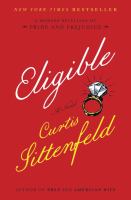It is a truth universally acknowledged that there can never be too many retellings of Jane Austen’s most popular novel, Pride and Prejudice (Yes, I had to do that. I apologize as humbly as Mr. Collins does.). Different settings, different viewpoints, different centuries, morals, and manners… the Lizzy/Darcy story seems to have a universality that transcends all other plot elements.
 Different setting: Soniah Kamal’s Unmarriageable is Pride and Prejudice set in Pakistan in 2000-2001. We can immediately recognize the Binat family with their five daughters. Kamat includes more descriptions of clothes, accessories, and food than Jane Austen ever did; and these details evoke the sense of place in a vibrant, unforgettable way. Opulent weddings and polo matches at exclusive venues take the place of balls and country dances. One thing I especially liked about this novel is how much more the author brings out the characters of the middle daughters in the family.
Different setting: Soniah Kamal’s Unmarriageable is Pride and Prejudice set in Pakistan in 2000-2001. We can immediately recognize the Binat family with their five daughters. Kamat includes more descriptions of clothes, accessories, and food than Jane Austen ever did; and these details evoke the sense of place in a vibrant, unforgettable way. Opulent weddings and polo matches at exclusive venues take the place of balls and country dances. One thing I especially liked about this novel is how much more the author brings out the characters of the middle daughters in the family.
Different viewpoint: Longbourn by Jo Baker is the story of Pride and Prejudice told from the point of view of the servants in the Bennet household, especially Sarah, the housemaid who acts as a lady’s maid to the Bennet daughters whenever she is required to do so; especially, for oh, say, an important ball where Bingley and Darcy will be in attendance. It’s so easy for us as an audience, safely ensconced in the twenty-first century, to admire Elizabeth’s lively independence and eye-brightening exercise striding through dirty lanes; but it’s quite another thing for the servant who is responsible for cleaning a petticoat six inches deep in mud!
 Different century: If anyone has successfully translated the Pride and Prejudice story into twenty-first century America, it’s Curtis Sittenfeld with her novel Eligible. Her sharp writing is the perfect contemporary voice for Austen’s elegant prose; and her intelligent observations on our society are comparable to Austen’s look at hers. Sittenfeld successfully integrates commentary on gender, relationships, and the expectations around women and their behavior into the story line for a truly refreshing look at this popular classic.
Different century: If anyone has successfully translated the Pride and Prejudice story into twenty-first century America, it’s Curtis Sittenfeld with her novel Eligible. Her sharp writing is the perfect contemporary voice for Austen’s elegant prose; and her intelligent observations on our society are comparable to Austen’s look at hers. Sittenfeld successfully integrates commentary on gender, relationships, and the expectations around women and their behavior into the story line for a truly refreshing look at this popular classic.
And finally, the one, the only Pride and Prejudice by Jane Austen herself. If you haven’t read it since high school, or if it’s been a long time, one of the particular pleasures of this novel is that you can see or understand something new every time you read it again. And again. And even again! I myself am well into the double digits with re-reading Pride and Prejudice, so I don’t exaggerate when I say that you really cannot read it too many times!
